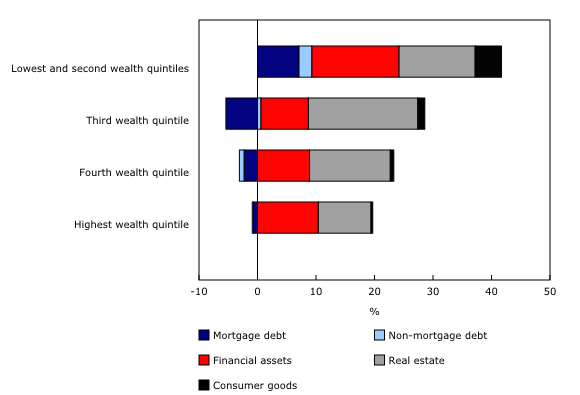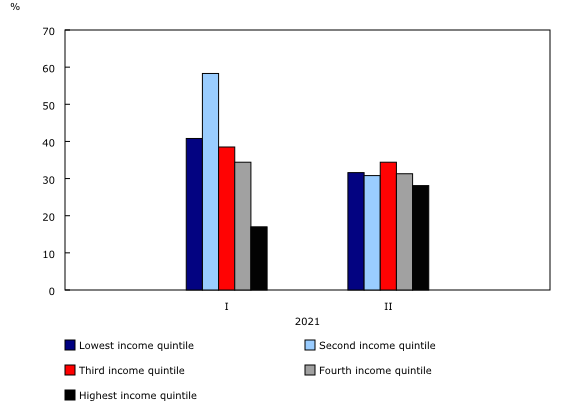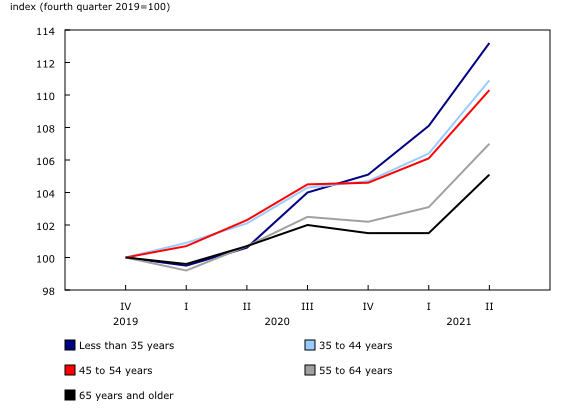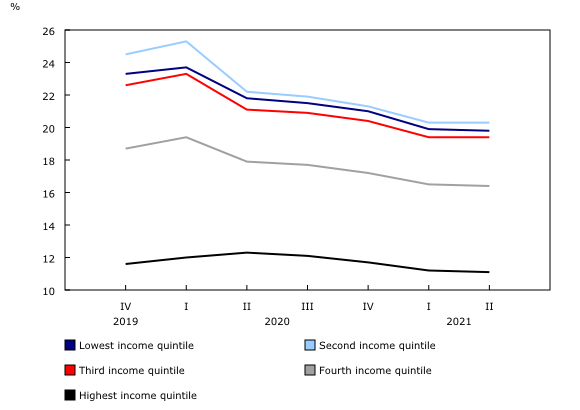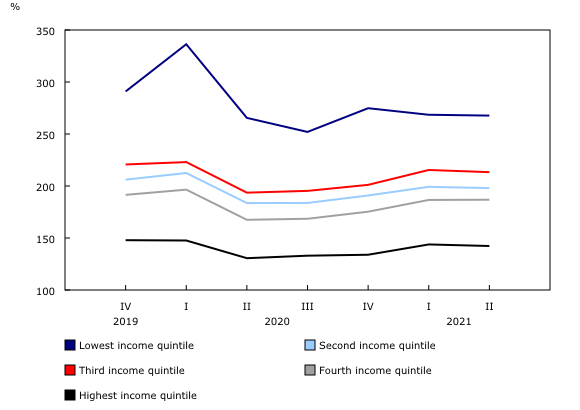Distributions of household economic accounts for wealth of Canadian households, first and second quarters of 2021
Archived Content
Information identified as archived is provided for reference, research or recordkeeping purposes. It is not subject to the Government of Canada Web Standards and has not been altered or updated since it was archived. Please "contact us" to request a format other than those available.
Released: 2021-10-26
This release of the distributions of household economic accounts (DHEA), which provides new data since the second quarter of 2020 up to the second quarter of 2021, reveals that the least wealthy and youngest households increased their net worth by more than other households since the onset of the COVID-19 pandemic.
While the results released today provide important insights into the average trends in the distributions of wealth for households with specific socioeconomic characteristics, not all households, even those with similar characteristics, necessarily experienced the same situations.
Despite the uncertainty and volatility that the pandemic has caused in people's everyday lives, on average, the net worth for households in Canada increased from the second quarter of 2020 up to the same quarter of 2021. The household wealth gap—a measure of economic well-being defined as the difference between the share of net worth for households in the highest wealth quintile and that for the two lowest wealth quintiles—declined in the second quarter of 2021 relative to the same quarter of 2020, as the net worth for the two lowest wealth quintiles increased at a faster pace than that for the wealthiest households.
Least wealthy increase share of net worth as their debt declines during the pandemic
Household wealth reached $14.2 trillion as of the second quarter of 2021, up $2.3 trillion (+19.3%) from the second quarter of 2020. While the wealthiest households (top 20%) held more than two-thirds (67.1%) of all net worth in Canada, those in the two lowest wealth quintiles—which accounted for 40% of all households—held 2.7% as of the second quarter of 2021.
While the value of assets owned by households in the two lowest wealth quintiles was relatively small, averaging $45,500 in financial assets and $88,900 in real estate as of the second quarter of 2021, their average wealth grew faster than other households. The two lowest wealth quintiles increased their net worth by 41.8% in the second quarter of 2021 from the second quarter of 2020, while those in the highest wealth quintile increased their net worth by less than half that rate (+18.8%).
Households in the two lowest wealth quintiles were the only group that reduced their average debt in the second quarter of 2021 relative to the second quarter of 2020. Decreases in average debt for the two lowest wealth quintiles occurred for both mortgage debt (-5.3%) and non-mortgage debt (-2.2%). Meanwhile, increases in average mortgage debt ranged from 13.3% for the highest wealth quintile to 15.5% for the third wealth quintile.
Gains in wealth for youngest households led by lower and middle income earners
Wealth grew the most for households with a major income earner aged less than 35 years in the second quarter of 2021, reaching an average of almost $309,000, up 30.8% from the second quarter of 2020. Three-quarters of the increase in wealth for the youngest households was due to real estate. Year-over-year gains in wealth for the youngest households were especially strong for those in the second income quintile in the first quarter of 2021 (+58.3%) and for the third income quintile in the second quarter of 2021 (+34.4%).
Households across income quintiles and age groups increase debt at fastest quarterly pace since the onset of the pandemic
Relative to the prior quarter, due partly to continued low interest rates, ongoing government support measures and seasonal effects, housing market activity heated up in the second quarter of 2021 as households increased their mortgage debt at the fastest pace since the end of 2019. Quarterly gains in mortgage debt were widespread, with households in each income quintile and age group increasing their average mortgage debt by about 5.0%.
Similarly, as business activity resumed in the second quarter of 2021, average non-mortgage debt balances—including credit cards, lines of credit and instalment loans—also increased for households in each income quintile and age group, at the fastest pace since the onset of the pandemic.
While increases in average debt for the second quarter of 2021 relative to the prior quarter were highest for the youngest age group (+5.2% for mortgage debt and 3.4% for non-mortgage debt), similar increases occurred for households with a major income earner aged 65 years and older (+4.3% for mortgage debt and +2.9% for non-mortgage debt).
Debt has recently been growing at a relatively fast pace for households across different age groups and income quintiles for a number of reasons. As noted in studies on the Canadian housing market that are based on similar data used to develop the DHEA estimates for wealth, households are increasing their debt to buy a first home, to buy an additional property for investment purposes or personal use, to renovate their existing home, as well as to provide financial assistance to other family members seeking to buy their own home (see, for example, Financial System Review and Are homeowners ready for higher rates? A closer look at trends in the Canadian mortgage market).
Financial risk indicators remain below pre-pandemic levels for each income quintile and age group
The debt-to-asset ratio is an indicator of the degree of leverage a household has in relation to its debt. The greater the debt leverage, the more susceptible a household may be to financial vulnerabilities in the future. On the other hand, as asset prices increase—such as real estate and financial assets like stocks and bonds—households are able to secure more debt without increasing their leverage.
Although households on average increased their mortgage and non-mortgage debt in the second quarter of 2021, they were less leveraged during the pandemic, as assets—mainly real estate—grew at a faster pace. As of the second quarter of 2021, the debt-to-asset ratio declined relative to the first quarter of 2020 for each income quintile and age group, especially for those in the second income quintile, at 20.3% (-5.1 percentage points) and those aged less than 35 years, at 35.4% (-5.4 percentage points).
The debt-to-asset ratio remained stable in the second quarter of 2021 relative to the previous quarter, as increases in mortgage and non-mortgage debt mirrored gains in financial and real estate asset values.
The debt-to-income ratio provides a different perspective on household financial risk, as it indicates the degree to which households may be able to service their debt at a given point in time.
Households in the lowest income quintile had the highest debt-to-income ratio in the second quarter of 2021, at 267.7%, although their ratio remains lower than its peak in the first quarter of 2020 (336.3%) as their income has continued to grow faster than their debt since the onset of the pandemic.
Similarly, while households with a major income earner aged 35 to 44 years had the highest debt-to-income ratio of any age group in the second quarter of 2021 (250.4%), their ratio has dropped 9.4 percentage points since the first quarter of 2020.
Note to readers
Statistics Canada regularly publishes macroeconomic indicators on household wealth (net worth) as part of the Canadian System of Macroeconomic Accounts (CSMA). These accounts are aligned with the most recent international standards and are compiled for all sectors of the economy, including households, non-profit institutions, governments and corporations along with Canada's financial position vis-à-vis the rest of the world. While the CSMA provide high quality information on the overall position of households relative to other economic sectors, the distributions of household economic accounts (DHEA) provide additional granularity to address questions such as vulnerabilities of specific groups and the resulting implications for economic well-being and financial stability, and are an important complement to standard quarterly outputs related to the economy.
The DHEA estimates released today provide new estimates of wealth and their sub-components by various household distributions for the first two quarters of 2021. Estimates for prior reference periods remain unchanged relative to those released on September 7, 2021. Estimates for wealth distributed by wealth quintile are combined for households in the lowest two quintiles for ease of illustration, since the average household in the lowest wealth quintile owed more in liabilities than it owned in assets, such as self-employed workers with negative net business equity and recent graduates with student loan balances.
As with all data, the DHEA estimates are not without their limitations. While some distributions are estimated using timely microdata, such as household liabilities, others, including household assets, rely on assumptions or use data from prior reference periods. Users should keep these limitations in mind when analyzing the estimates included in this release.
All values are expressed in quarterly nominal unadjusted rates, unless otherwise specified.
Products
The data visualization product "Distributions of Household Economic Accounts, Wealth: Interactive tool," which is part of Statistics Canada – Data Visualization Products (71-607-X), is now available.
The document, "Distributions of Household Economic Accounts, estimates of asset, liability and net worth distributions, 2010 to 2020, technical methodology and quality report," which is part of the Income and Expenditure Accounts Technical Series (13-604-M), is available.
The Economic Accounts Statistics Portal, accessible from the Subjects module of our website, features an up-to-date portrait of national and provincial economies and their structure.
The Methodological Guide: Canadian System of Macroeconomic Accounts (13-607-X), is available. See the section "Distributions of Household Economic Accounts."
The publication Latest Developments in the Canadian Economic Accounts (13-605-X) is available.
The User Guide: Canadian System of Macroeconomic Accounts (13-606-G) is available.
Contact information
For more information, or to enquire about the concepts, methods or data quality of this release, contact us (toll-free 1-800-263-1136; 514-283-8300; STATCAN.infostats-infostats.STATCAN@canada.ca) or Media Relations (613-951-4636; STATCAN.mediahotline-ligneinfomedias.STATCAN@canada.ca).
- Date modified:


